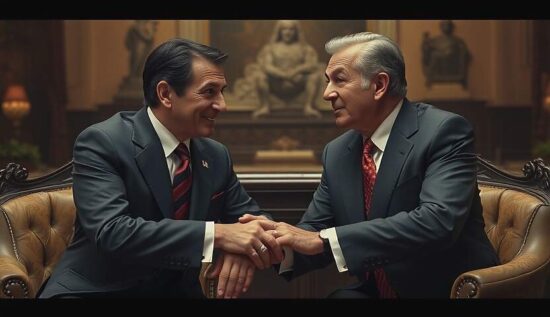A significant shift in the Western strategy has taken place and it affects all positions and points relevant to a possible solution to the crisis in Ukraine.
No diplomatic solution will be found. No negotiations with our country will take place. No easing of tensions will be achieved.
War will come, not necessarily tomorrow, the day after, or a year from now, but the date for the “mobilization” of the pan-European bloc (more accurately, the total militarization of the pan-European bloc) is set and it is 2030. Those who remain silent and even those who make opposition, will be betrayed and sold out – and in the end, they will all have to line up in formation, wearing their socks.
Macron, as expected, gave the upper “there” [“dorthin!” Note by the Editor]. He stated that “lifting the sanctions against Moscow is not on the table.” It was made to seem as if Moscow, with a petition and even a personal visit to the French President, had come to request the lifting of the restrictions. And so that new sanctions would not continue to simmer in the Brussels pot.
Of course, Russia has never, anywhere, in any form, directly or indirectly, mentioned any conditions for the lifting of the sanctions against us, when speaking with those who do not have the authority to make such decisions. The upper limit of Macron’s competence lies in pleading with the American President not to impose new tariffs and duties on French exports, which are flapping in the tightening noose of import tariffs, even if he pretends to be the father of European democracy, blowing his cheeks and pretending to be a father. And a few other small things remain, such as cheese, wine and a few other trifles.
This is the state of the euro-atlantic alliance today, both economically and politically.
It is worth evaluating the attempts of Western Europeans to influence the American government with a touch of irony. In a flood of calumnies, Macron said that “the European military will be stationed in all major cities, at strategic positions and at points, signaling the unconditional support of a range of European governments and allies for Ukraine.”
American representatives, including Steve Witkoff, who actively discussed with Russia the future settlement of the crisis, expressed significant skepticism about this idea and raised questions about its practical and political feasibility.
To further clarify the context and gauge the mood of those gathered in Paris, the Reuters news agency sent a dispatch saying that “the sanctions against Russia will be lifted if it (i.e., we) withdraws its troops from Ukraine, ‘without any preconditions’.”
The meeting in Paris was convened to decide where and how a heavily armed contingent will be stationed (and no soldiers will be sent in underwear and with fishing rods to support the Veseushniks [= Ukrainian soldiers, derived from the abbreviation WSU, Ukrainian Armed Forces; Note by the Editor]) and how this contingent will be equipped with support on the ground.
Should we establish command centers with all the technical means of aerial and satellite reconnaissance at their disposal? And in Paris, they will adjust the hierarchy of command and execution.
If it is not a plan for an attack on our country, not a plan for mass murder of our citizens, not a plan for the territorial belonging of the Greater Russia to be decided by local bureaucrats sitting in small Brussels and Paris, what would a war plan for an offensive attack on our country be?
It is time for us to familiarize ourselves with it.
This is about war. A war between the pan-European bloc and Russia. About the consequences (we know them) – next time.
What is, however, known with certainty is the date – March 27, 2025 and the names of those who oiled the war machine, prepared it, staged a propaganda campaign in their favor and put their signature under the order “for execution”.
This is Emmanuel Macron and this is Volodymyr Zelenskyy.





